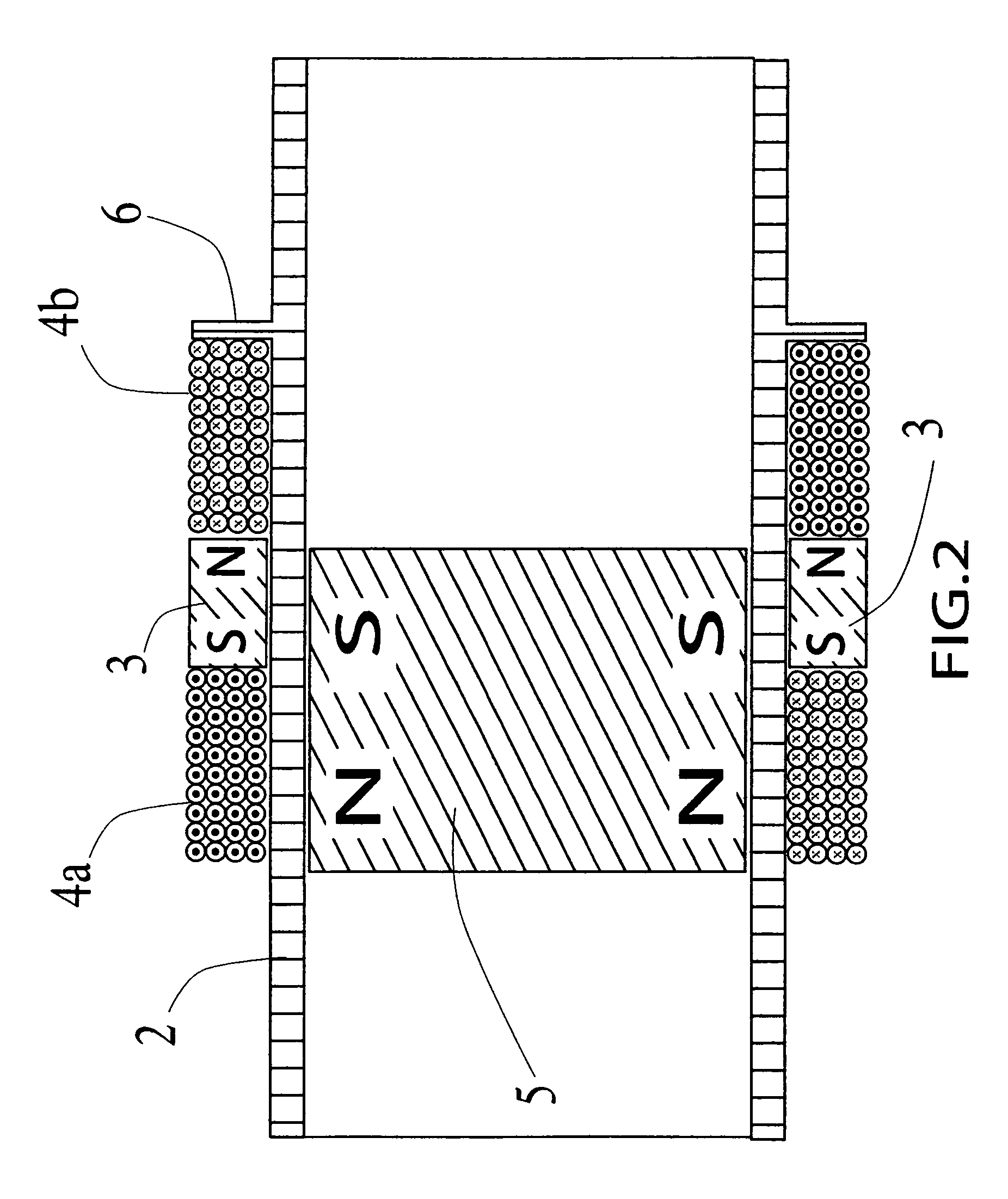Low frequency electromagnetic motor to create or cancel a low frequency vibration
a low frequency electromagnetic and motor technology, applied in the direction of magnets, mechanical energy handling, magnetic bodies, etc., can solve the problems of uneven spring load, frequent service, and application of this device in an audio system
- Summary
- Abstract
- Description
- Claims
- Application Information
AI Technical Summary
Benefits of technology
Problems solved by technology
Method used
Image
Examples
first embodiment
[0028]FIGS. 1 and 2 illustrate the present invention in a longitudinal cross-sectional view of the electromagnetic motor. Looking first at FIG. 1, the stator of the electromagnetic motor includes a tube 2 of a non-ferrous (non-magnetic) material (e.g., aluminum, plastic, etc.) that has a selected length and inner diameter. The ends of tube 2 are shown open, however a non-ferrous cap can be placed on each end to prevent foreign material from entering tube 2 which could imped the free movement of the piston. Additionally, a hollow core magnet 3 (i.e., a doughnut magnet) is substantially centered longitudinally on the outside of tube 2 with the diameter of the center hole in magnet 3 being substantially the same as the outer diameter of tube 2. Further, wound around the outside of tube 2, on opposite sides of magnet 3, are two electrically conductive coils 4a and 4b (i.e., inductors or voice coils) each next to, or equally spaced apart from (FIG. 5), the sides of magnet 3. Also shown i...
second embodiment
[0038]Experimental results point to the best design for the second embodiment being: the inclusion of a thin walled tube 2 to yield cooler operation and a stronger magnetic flux coupling between the stator and the piston; magnets 3 and 5 being substantially equal in width; each of plates 1 having substantially the same width as magnet 5 (i.e., a piston width that is three times the width of magnet 5); coils 4a and 4b being equal to each other in width and inductive value; each of coils 4a and 4b having a width that is approximately 20% greater than the width of a single plate 1; and the strength of the signals applied to coils 4a and 4b being such to cause each of the coils to generate a magnetic field of equal strength, thus if coils 4a and 4b are as described above (i.e., of equal width and equal inductive value then the signals would be substantially the same thus permitting coils 4a and 4b to be wired in series, while maintaining the reverse winding as shown, and a single signal...
third embodiment
[0044]As in previous embodiments as illustrated in the respective figures, FIG. 7 is a horizontal cross-section of the third embodiment with the piston at the furthest travel point to the left with a maximum steady-state signal on stator windings 4a and 4b.
[0045]With the stator components in a configuration as shown in FIGS. 6 and 7, experimental results indicate that the best performance is achieved when the sum of the widths of spacers 10b, 10c and 10d, and the widths of magnets 9a and 9b is substantially equal to the width of one of coils 4a and 4b where the widths of coils 4a and 4b are substantially the same as each other.
[0046]FIG. 8 is a horizontal cross-section of a modified third embodiment with the piston at the furthest travel point to the left with a maximum steady-state signal on stator windings with the piston only having magnets 11 without plates 1 that are shown in FIGS. 6 and 7.
PUM
 Login to View More
Login to View More Abstract
Description
Claims
Application Information
 Login to View More
Login to View More - R&D
- Intellectual Property
- Life Sciences
- Materials
- Tech Scout
- Unparalleled Data Quality
- Higher Quality Content
- 60% Fewer Hallucinations
Browse by: Latest US Patents, China's latest patents, Technical Efficacy Thesaurus, Application Domain, Technology Topic, Popular Technical Reports.
© 2025 PatSnap. All rights reserved.Legal|Privacy policy|Modern Slavery Act Transparency Statement|Sitemap|About US| Contact US: help@patsnap.com



